There are some basic gardening preparations you need to make so that you can be sure your garden will recover well from the cold winter months. You need to find time to clear away debris, get fertilizer, dig flowerbeds, and many more. It is also important to decide ahead of time whether you intend your garden to be productive or relaxing this year.
A productive garden means deciding on food plants, picking out the best areas for the types of seedlings, arranging for proper shading to avoid too much sun exposure, and having fencing installed to give pea plants and raspberry bushes a trellis to grow against.
A relaxing garden is primarily meant for aesthetic appeal. Your planting will mainly focus on flowering bushes and vines, so visual enjoyment and the shading will be decided by where you place your lawn furniture.
You will also need to arrange for a mosquito control firm to come out and ensure that you do not get eaten alive while enjoying your garden. Plant citronella and lavender help keep the pests away after the treatments and for the delightful aroma they provide.
Having a green thumb is not a quirk of nature. It is about developing the patience and willingness to work with nature to become a good gardener.
Tool Preparation
Dig out your gardening tools and clean them. Metal tools may need de-rusting and oiling so prepare a tarp to place them on as this can get very dirty fast. Use a stiff brush to get rid of any caked-on mud. Keep a bucket of water handy to help soften the mud and wash away dirt after the cleaning.
Plant Beds and Borders
Stake out where you want the plant beds to be and begin preparing the surface. Mow the lawn and then mark where the beds will be situated. Make sure to mark the exact size the entire bed plus border will take. You will need furrows between the beds to aid irrigation, and this must be included when marking out the space.
Remember to work the soil when it is moist. Dry soil will give be hard to dig and turn over. Wet soil will clump and not give the right amount of mix you want. Use a shovel or a sturdy tiller to ensure that you get a turnover of soil between 12 and 18 inches.
Next, layer organic compost up to three inches (around eight cm) thick over the bed. Use the shovel to turn over the soil again so that the compost mixes into the soil. This will make the soil more nutritious and make it easier for seedlings to take root. Once the compost is mixed in well, level the beds and apply a layer of mulch. This is to prevent weeds from germinating and taking over your freshly prepared plant bed.
Weeding

Weeding is a time-consuming activity that must be done. You could employ your children to do the weeding for you as part of their chores. If you are looking for exercise, then you may want to do it yourself.
Spring is the best time to begin, as the weed will show themselves at the first hint of warmth. Weeding in spring will clear up your garden, help it to look neat, and keep your soil fertile for your plants. Weeds soak up the nutrition in your garden soil, leaving it a weak ground for your plants.
Garden Pests
Once you have weeded, go over every remaining plant to check for pests. Some types of bugs are good for a garden, but others can cause a lot of destruction. Certain types of caterpillars and slugs can eat their way through all your plants and bushes and destroy all your hard work.
Get familiar with common pests so you can prepare beforehand for dealing with them at the first sign of infection. Pesticides are most effective for aphids, alder leaf beetles, and mites. There are natural treatments, so it is up to you whether you want to take a more human approach.
Pigeons and caterpillars can be thwarted by putting netting around your plants. This will prevent them from access and keep them from eating your young shoots and leaves. A wire fence can keep your plants safe from rabbits.
Add further barriers to this wire fence to keep away snails. Spread out coffee grounds and crushed eggshells around the wire fence to create an additional layer of repellent. Some slugs and snails can cause just as much damage as a hungry rabbit, so a double layer of protection is best.
When you get started, you will find that you can easily recall how to help your garden look its best. Do remember that the entire backyard plays a part in setting off your garden. Clean up all visible areas and repair any damage to the fence and patio.
Set up a bird table and keep it clean and stocked with seeds. This will add to the appeal of your garden and give the birds an incentive to stay away from your plant beds. Once this is all done, you will have your relaxing and beautiful garden ready to enjoy.

